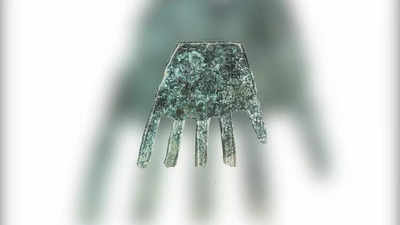Trending
Archaeologists discover 2,000-year-old hand inscribed with mysterious writing
Archaeologists in northern Spain uncover the Hand of Irulegi, a 2,000-year-old bronze artifact adorned with enigmatic symbols possibly linked to the Basque language. Believed to be apotropaic, it challenges assumptions about the Vascones' literacy and sheds light on ancient cultural practices. Linguistic analysis reveals its connection to Paleohispanic languages, marking a significant find in Vasconic epigraphy. As decipherment efforts continue, the hand offers insights into ancient communication and cultural continuity.

Archaeologists in northern Spain have excavated a bronze hand with an inscription in a mysterious ancient language of a people byegone. Source: M. Aiestaran, J. Velaza, et al/Antiquity/Cambridge University
Archaeologists in northern Spain have unearthed a remarkable artifact that is illuminating the mysterious past of the Vascones, an ancient tribe with scant written records. The Hand of Irulegi, a bronze relic dating back 2,000 years to the Iron Age, was discovered adorned with four lines of enigmatic symbols that may represent a graphic subsystem of Paleohispanic languages, closely related to the modern Basque language.
The hand was likely displayed at the entrance of a building, as suggested by its orientation and the position of a small hole, indicating it may have been hung for viewers to see upon entering. The inscriptions, created using the sgraffito technique and enhanced with larger punched dots, suggest the use of a sharp iron tool, possibly a burin, for their creation.

Linguistic analysis has drawn a connection between the first word on the hand, ‘sorioneku,’ and the Basque word ‘zorioneko,’ which means ‘of good fortune.’ This suggests that the hand’s message was apotropaic, intended to bring good luck or ward off harm. The researchers believe that the hand may have held ritual or cultural significance, possibly related to ancient Iberian practices of severing the right hands of captives, although the hand’s use appears to have been more benign. “The text inscribed on this artifact, which was found at the entrance of a domestic building, is interpreted as apotropaic, a token entreating good fortune,” the researchers explained in the published paper. They further suggested that "the script represents a graphic subsystem of Palaeohispanic that shares its roots with the modern Basque language and constitutes the first example of Vasconic epigraphy."
The artifact’s inscription is currently undergoing decipherment, which promises to provide further insights into the language, beliefs, and cultural practices of the Vascones. This find not only paves the way for a deeper understanding of Spain’s rich history but also highlights the diverse voices that shaped its past.
The Hand of Irulegi stands as a testament to the sophisticated cultural practices of the Iron Age inhabitants of the region. It serves as a bridge between the past and the present, offering clues to the linguistic and cultural continuity from the Iron Age to today.
As the research continues, the Hand of Irulegi will undoubtedly contribute to our knowledge of ancient communication methods and the evolution of language. It is a symbol of the past reaching out to the present, urging us to explore, to learn, and to remember the complexity and depth of human history.
The hand was likely displayed at the entrance of a building, as suggested by its orientation and the position of a small hole, indicating it may have been hung for viewers to see upon entering. The inscriptions, created using the sgraffito technique and enhanced with larger punched dots, suggest the use of a sharp iron tool, possibly a burin, for their creation.

The Irulegi hand being excavated by archaeologists on site. The hand was most probably used as an apotropaic. Source: M. Aiestaran, J. Velaza, et al/Antiquity/Cambridge University
Linguistic analysis has drawn a connection between the first word on the hand, ‘sorioneku,’ and the Basque word ‘zorioneko,’ which means ‘of good fortune.’ This suggests that the hand’s message was apotropaic, intended to bring good luck or ward off harm. The researchers believe that the hand may have held ritual or cultural significance, possibly related to ancient Iberian practices of severing the right hands of captives, although the hand’s use appears to have been more benign. “The text inscribed on this artifact, which was found at the entrance of a domestic building, is interpreted as apotropaic, a token entreating good fortune,” the researchers explained in the published paper. They further suggested that "the script represents a graphic subsystem of Palaeohispanic that shares its roots with the modern Basque language and constitutes the first example of Vasconic epigraphy."
The discovery of the Hand of Irulegi is significant as it challenges the previously held belief that the Vascones were pre-literate. The detailed linguistic analysis suggests that the script represents a distinct sub-system of Paleohispanic that shares its roots with the modern Basque language, marking the first example of Vasconic epigraphy.
The artifact’s inscription is currently undergoing decipherment, which promises to provide further insights into the language, beliefs, and cultural practices of the Vascones. This find not only paves the way for a deeper understanding of Spain’s rich history but also highlights the diverse voices that shaped its past.
The Hand of Irulegi stands as a testament to the sophisticated cultural practices of the Iron Age inhabitants of the region. It serves as a bridge between the past and the present, offering clues to the linguistic and cultural continuity from the Iron Age to today.
As the research continues, the Hand of Irulegi will undoubtedly contribute to our knowledge of ancient communication methods and the evolution of language. It is a symbol of the past reaching out to the present, urging us to explore, to learn, and to remember the complexity and depth of human history.
WHAT! Taylor Swift and American poet Emily Dickinson are related? Deets inside
End of Article
FOLLOW US ON SOCIAL MEDIA









